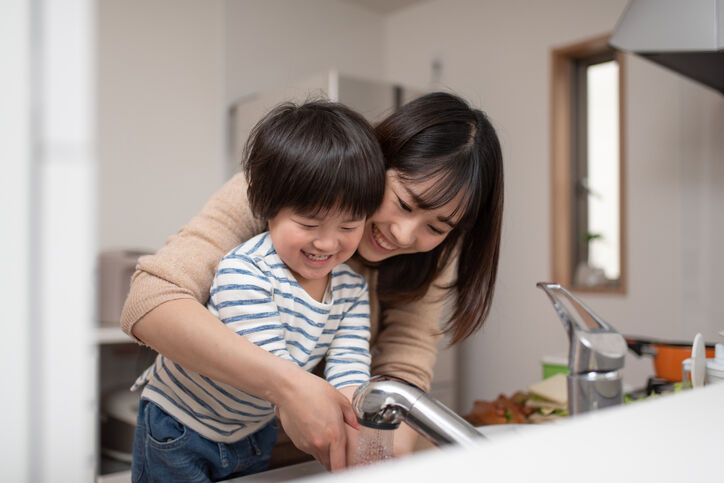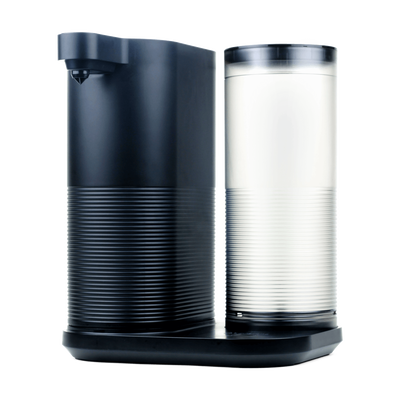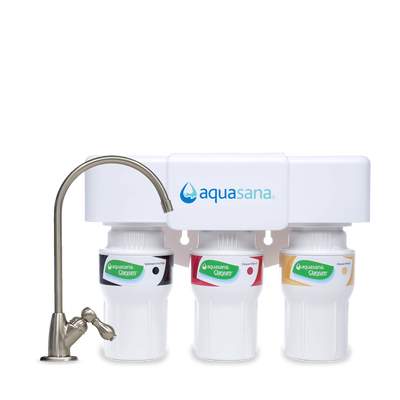Filtered water
What is filtered water?
Filtered water is tap water that is treated by going through a water filtration system. There are many types of systems and ways to filter water, but they all essentially work to remove contaminants from water in your home.
Benefits of filtering tap water
Compared to boiling, filtering water is a much faster process that enables people to enjoy clean, healthy drinking water with the touch of a button or lift of a faucet handle. Furthermore, filtered water is usually held to higher standards than water purified through boiling. In fact, outside groups such as NSF rate water filters based on their ability to remove contaminants. Filtering water is healthier to drink, better on your skin when showering, and helps keep clothes fresher if used for laundry. A wide range of water filtration options such as whole house, under sink, and shower filters also means you can choose where and how you want to filter in your home.

Disadvantages of filtering tap water
There really aren't any health disadvantages of filtering tap water, although the system itself and price of future replacements should be considered. You'll also want to think about installation complexity, as some water filters such as our Clean Water Machine can simply be plugged in while others such as our SmartFlow® Reverse Osmosis may require tools or assistance from a professional.
Ways to filter tap water
- Ultra Violet (UV) Filters: UV filters are an ultra-effective way to help purify water by using different frequencies of ultraviolet light. Essentially, the DNA in microbial cells absorbs the light — killing bacteria and viruses. However, UV filters will not remove other contaminants such as chlorine, lead, or chemicals which is why they should be used in conjunction with other types of filters.
- Reverse Osmosis: Reverse osmosis systems are generally regarded as the most effective water filter for removing contaminants. They work by pushing water through a reverse osmosis membrane under pressure, leaving the contaminants on one side and purified water on the other. Aquasana's SmartFlow® Reverse Osmosis water filter removes 5x more contaminants than other RO systems while retaining beneficial minerals.
- Activated Carbon: This is the most common type of filter, which works by pulling impurities from water and binding it to char created from activated charcoal in the filter. Although this is a great start, these filters should be used alongside other filtration methods to better safeguard water from viruses and bacteria.
- Ion Exchange: Ion exchange filters are most commonly used to treat hard water, and they work by exchanging one ion for another from water passing through it. Typically, they replace hardness-causing ions such as calcium or magnesium with sodium to soften tap water. These filters are great for this purpose, but they do not remove bacteria or other particles as effectively as other filtration methods.
- Mechanical: Mechanical filters are usually the first part of a full filtration system, as it works by catching physical materials using nylon floss, synthetic foam, or pads. These should be used as a pre-filter rather than an overall solution.
Comparing boiled and filtered water
There’s a lot of confusion about how you should make sure the water you drink is safe and healthy, but the overwhelming conclusion is that filtered water is a better solution than boiling it.
When looking at boiled vs filtered water, we found that boiling water isn’t enough to completely purify water because it leaves harmful contaminants such as lead and chlorine. Additionally, using a water filter offers much more convenience by enabling you to enjoy healthy, great-tasting water at the touch of a button or lift of a handle compared to waiting for water to boil and cool.
Overall, filtered water is better for your health and comes with a host of other benefits compared to boiled water. Aquasana has a wide variety of water filtration solutions to help you provide clean water to any or all areas of your home. To get filtered water from every faucet, consider a whole house water filter. If you just want filtered water from your kitchen, consider an under sink or easy to install countertop filter.
Have more questions about which Aquasana water filter is right for you? Contact us and we’ll help find a solution catered to the unique needs of your home!



